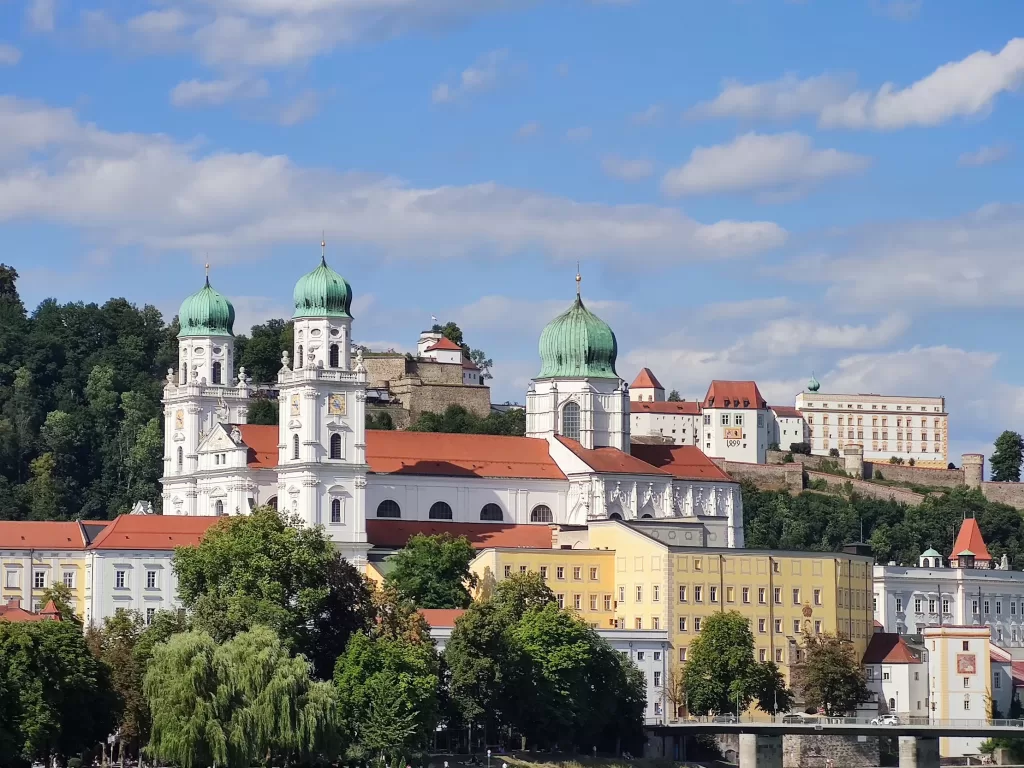 Passau, known as the Three Rivers City, borders Austria in Germany. The Ilz, Inn, and the renowned Donau rivers run through the city. However, I view this city as a quaint, traditional, and country version of Manhattan and New York, shape-wise.
Passau, known as the Three Rivers City, borders Austria in Germany. The Ilz, Inn, and the renowned Donau rivers run through the city. However, I view this city as a quaint, traditional, and country version of Manhattan and New York, shape-wise.
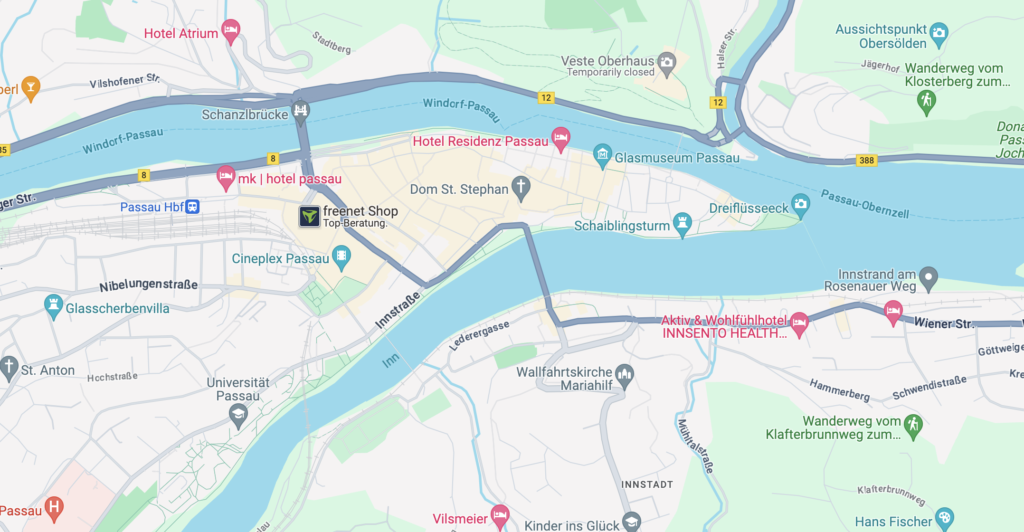 Passau’s cityscape features a triangular peninsula, with areas across the Inn and Donau rivers on the hills, making the peninsula resemble “Manhattan” and the sides, “Brooklyn” and “Jersey City.” In terms of ambiance, due to Catholic influence in Bavaria, Passau is very much like München – its old town is Baroque styled, with numerous churches, and even features a main church with two onion heads similar to Frauenkirche in München!
Passau’s cityscape features a triangular peninsula, with areas across the Inn and Donau rivers on the hills, making the peninsula resemble “Manhattan” and the sides, “Brooklyn” and “Jersey City.” In terms of ambiance, due to Catholic influence in Bavaria, Passau is very much like München – its old town is Baroque styled, with numerous churches, and even features a main church with two onion heads similar to Frauenkirche in München!
Activities and What to Do in Passau:
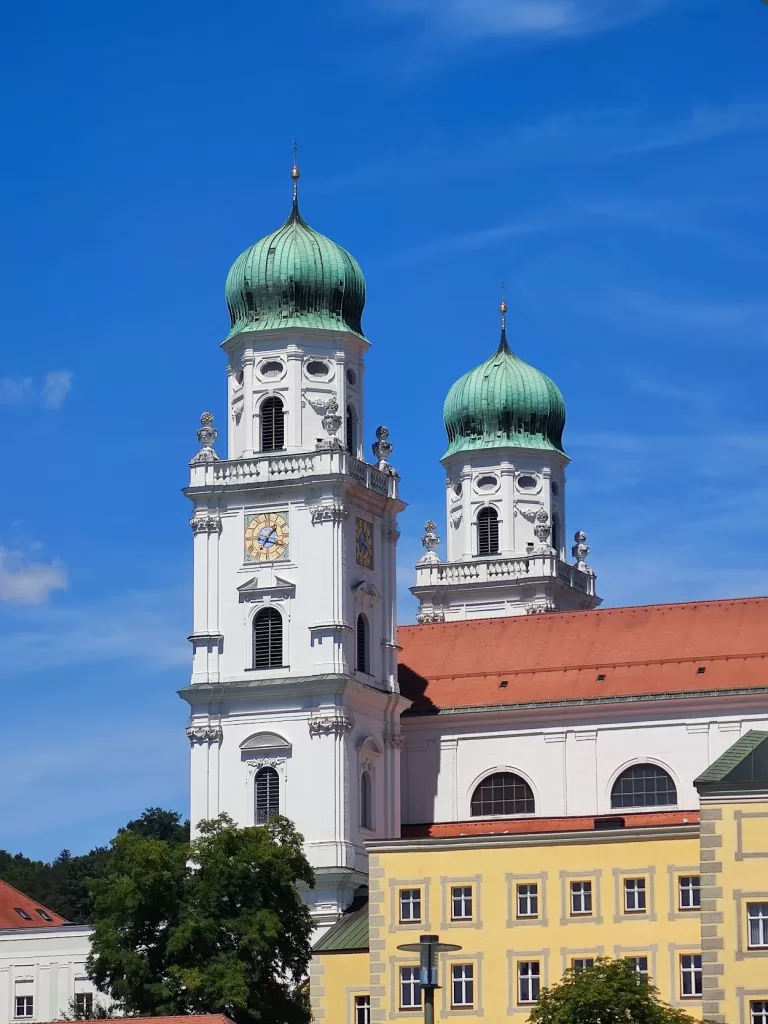 St. Stephan’s Cathedral and Surroundings: This Baroque cathedral, notable for its long history and the largest church organ outside the US, has two onion heads on its towers. The Wittelsbacherbrunnen (a fountain), located behind the cathedral, serves as a popular meeting spot, likely due to the nearby cafes.
St. Stephan’s Cathedral and Surroundings: This Baroque cathedral, notable for its long history and the largest church organ outside the US, has two onion heads on its towers. The Wittelsbacherbrunnen (a fountain), located behind the cathedral, serves as a popular meeting spot, likely due to the nearby cafes.
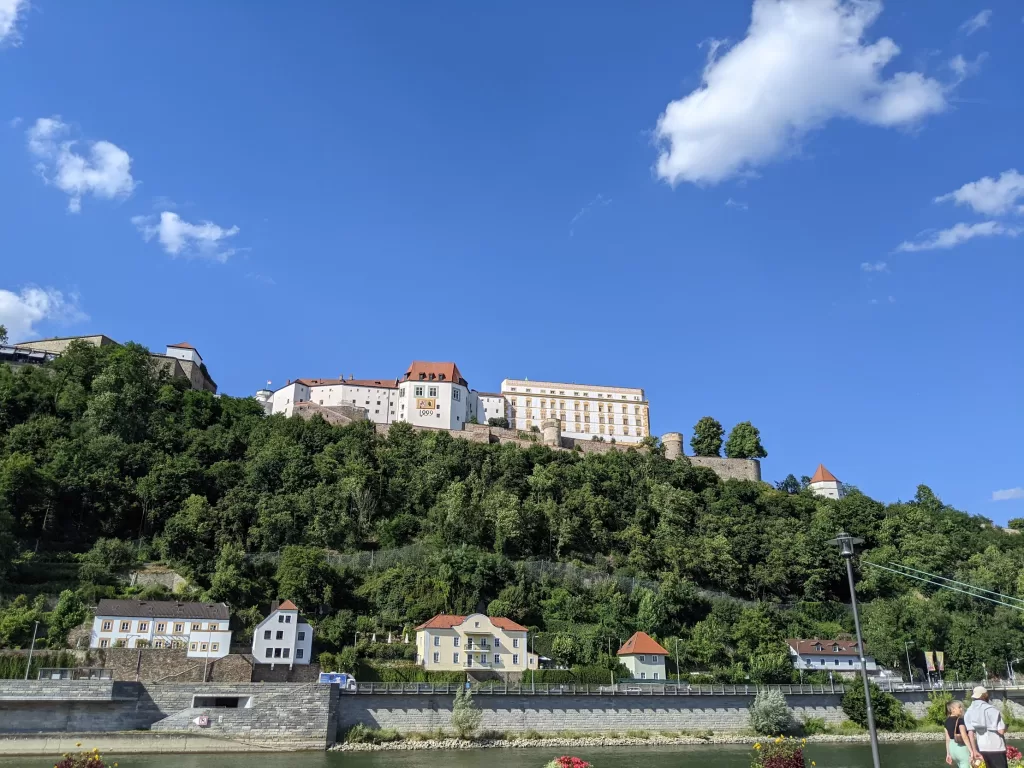 Veste Oberhaus Castle: A castle standing on a hill next to the city, truly a castle from ancient times: a fortification. Remarkably, this castle was attacked five times but never conquered. Its walls, made of bricks and stones, are notably thick, aiding in its defense.
Veste Oberhaus Castle: A castle standing on a hill next to the city, truly a castle from ancient times: a fortification. Remarkably, this castle was attacked five times but never conquered. Its walls, made of bricks and stones, are notably thick, aiding in its defense.
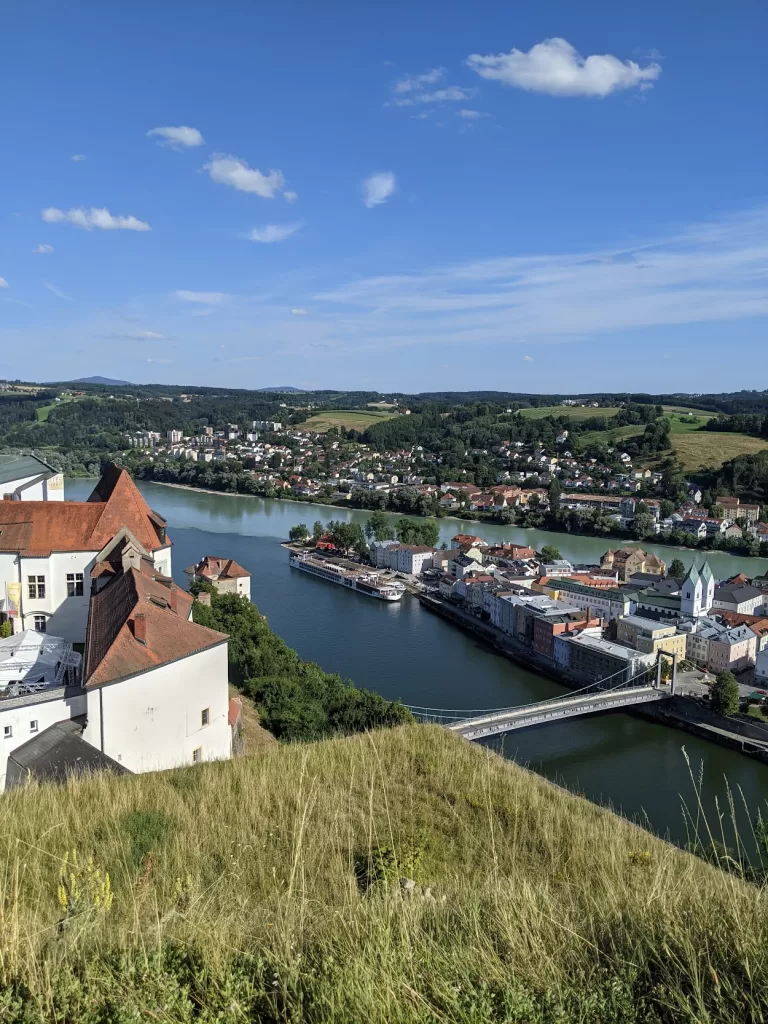
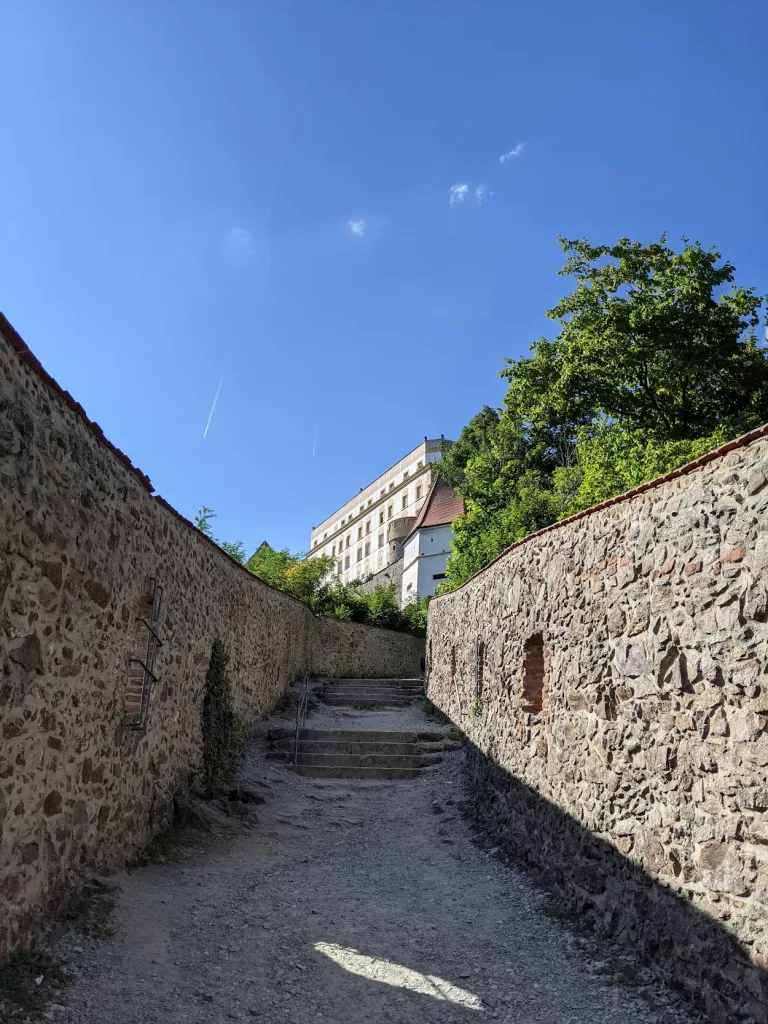 The highest point of the Veste Oberhaus offers a spectacular view of the old town of Passau, as well as the rivers. If one reaches the corner of the castle, they can see how the three rivers merge together: the Inn being green, the Donau being blue, and the Ilz being black.
The highest point of the Veste Oberhaus offers a spectacular view of the old town of Passau, as well as the rivers. If one reaches the corner of the castle, they can see how the three rivers merge together: the Inn being green, the Donau being blue, and the Ilz being black.
To me, having visited beautiful castles before, the Veste Oberhaus is not on the romantically beautiful side. However, it was a good place to learn about history and experience how a fortification functioned in ancient times.
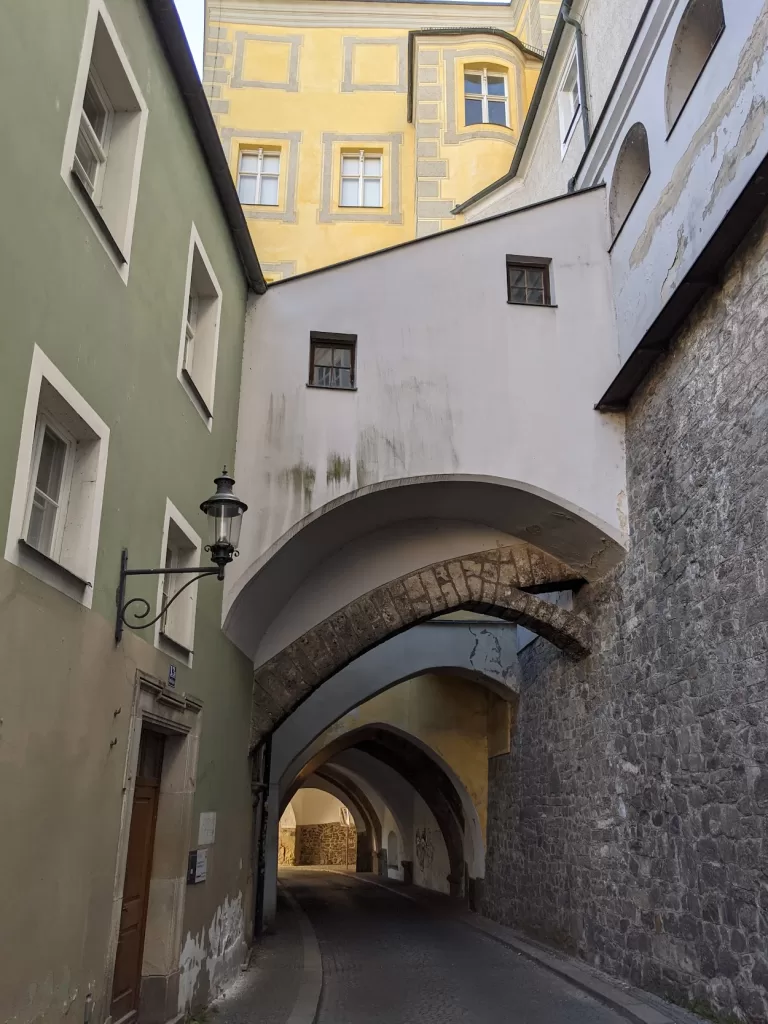 As I have mentioned many times in my other blogs, the core of a German city is really the Altstadt, and Passau is no exception. What I found different in this one is not the untouched houses but all those small alleys – they are really narrow, and many of them have arch structures that connect buildings. Some of them serve as gateways linking buildings, while for others, I had no idea and wondered what they are for if people cannot go through them.
As I have mentioned many times in my other blogs, the core of a German city is really the Altstadt, and Passau is no exception. What I found different in this one is not the untouched houses but all those small alleys – they are really narrow, and many of them have arch structures that connect buildings. Some of them serve as gateways linking buildings, while for others, I had no idea and wondered what they are for if people cannot go through them.
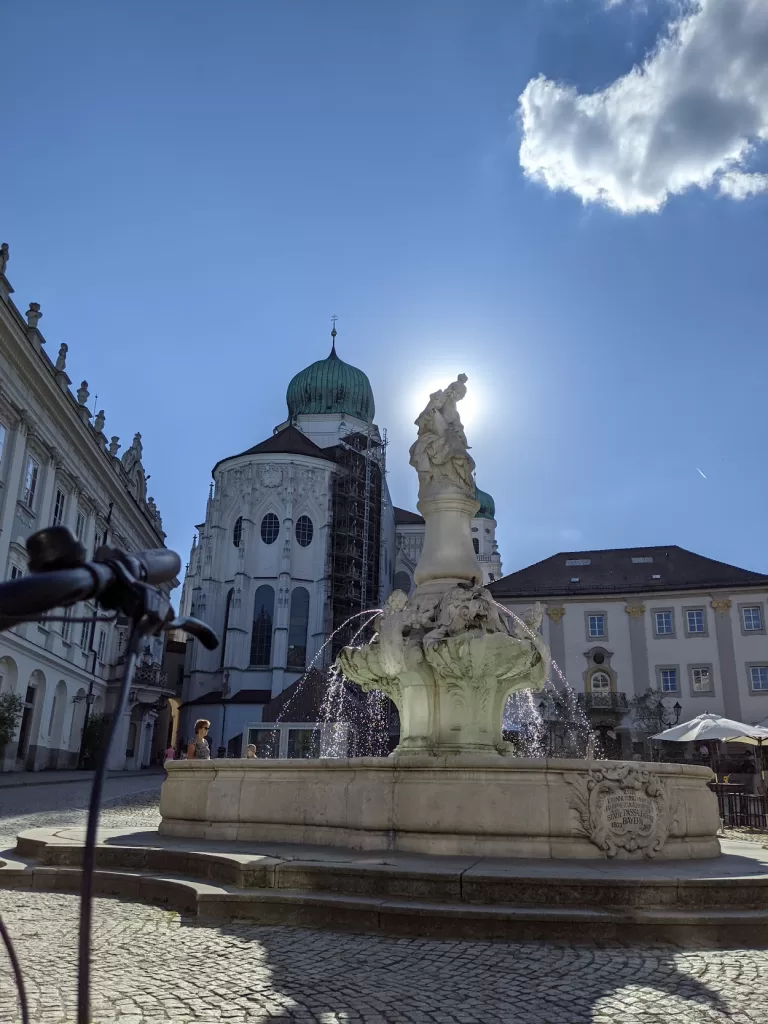 While Passau might not have stolen my heart like other German locales, its unique confluence of three rivers and its rich history still made it an intriguing destination. The city’s blend of natural beauty, architectural marvels, and narrow, mysterious alleys invites visitors to explore its many layers. Passau stands as a testament to the diverse charms that smaller, less celebrated cities possess, offering a distinctive experience that’s well worth the journey.
While Passau might not have stolen my heart like other German locales, its unique confluence of three rivers and its rich history still made it an intriguing destination. The city’s blend of natural beauty, architectural marvels, and narrow, mysterious alleys invites visitors to explore its many layers. Passau stands as a testament to the diverse charms that smaller, less celebrated cities possess, offering a distinctive experience that’s well worth the journey.
Passau: Exploring the City at the Crossroads of Three Rivers

Passau, known as the Three Rivers City, borders Austria in Germany. The Ilz, Inn, and the renowned Donau rivers run through the city. However, I view this city as a quaint, traditional, and country version of Manhattan and New York, shape-wise.

Passau’s cityscape features a triangular peninsula, with areas across the Inn and Donau rivers on the hills, making the peninsula resemble “Manhattan” and the sides, “Brooklyn” and “Jersey City.” In terms of ambiance, due to Catholic influence in Bavaria, Passau is very much like München – its old town is Baroque styled, with numerous churches, and even features a main church with two onion heads similar to Frauenkirche in München!
Activities and What to Do in Passau:

St. Stephan’s Cathedral and Surroundings: This Baroque cathedral, notable for its long history and the largest church organ outside the US, has two onion heads on its towers. The Wittelsbacherbrunnen (a fountain), located behind the cathedral, serves as a popular meeting spot, likely due to the nearby cafes.

Veste Oberhaus Castle: A castle standing on a hill next to the city, truly a castle from ancient times: a fortification. Remarkably, this castle was attacked five times but never conquered. Its walls, made of bricks and stones, are notably thick, aiding in its defense.

The highest point of the Veste Oberhaus offers a spectacular view of the old town of Passau, as well as the rivers. If one reaches the corner of the castle, they can see how the three rivers merge together: the Inn being green, the Donau being blue, and the Ilz being black.

To me, having visited beautiful castles before, the Veste Oberhaus is not on the romantically beautiful side. However, it was a good place to learn about history and experience how a fortification functioned in ancient times.

As I have mentioned many times in my other blogs, the core of a German city is really the Altstadt, and Passau is no exception. What I found different in this one is not the untouched houses but all those small alleys – they are really narrow, and many of them have arch structures that connect buildings. Some of them serve as gateways linking buildings, while for others, I had no idea and wondered what they are for if people cannot go through them.

While Passau might not have stolen my heart like other German locales, its unique confluence of three rivers and its rich history still made it an intriguing destination. The city’s blend of natural beauty, architectural marvels, and narrow, mysterious alleys invites visitors to explore its many layers. Passau stands as a testament to the diverse charms that smaller, less celebrated cities possess, offering a distinctive experience that’s well worth the journey.